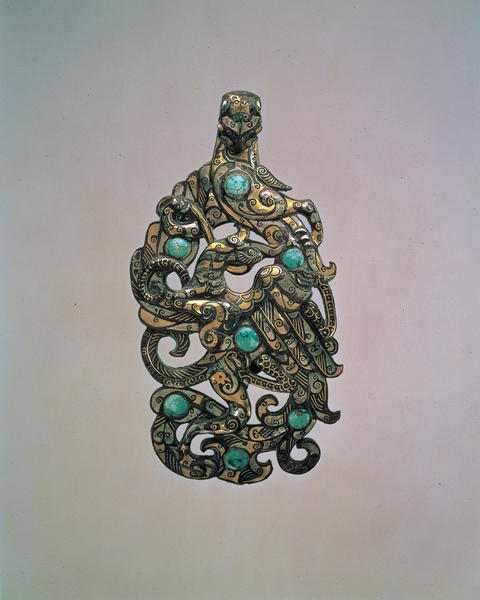Belt Hook
- China
- China, Late Eastern Zhou period
- 3rd century B.C.
- Bronze, gold and silver foil and turquoise inlays
- H-15.2
Catalogue Entry
Similar to catalogue number 93 in its openwork plaque-like format but larger and considerably grander, this belt hook displays one of the most complex designs of its kind known. Under close scrutiny, its intricately intertwined and overlapping elements crystallize into two creatures, a sinuous-bodied feline and a fancy-feathered bird, locked in fierce struggle.
With its head reared backward to form the hook, a feline looks straight down at its victim, whose head (with open beak) and neck strain back in an arch as the feline yanks the bird's long plume with the sharp claws of its left forelimb. One of the bird's scaled and feathered wings unfolds and extends from behind its strained neck, obscuring the body of the feline although the overlapping feathers are gripped by its right forelimb. The bird's two thin, scaled legs bend upward on either side of the wings. The feline's body emerges from underneath the bird's wings, to show two clawed hind limbs, the right extending to grab the end of the bird's long tail, while the left reaches up to clutch the bird's strained neck. The feline's curled tail, marked by striations and heart-shaped motifs, issues from behind the legs. The bird's other wing is visible, extending upward under the left front leg of the feline.
Every part of the feline's and bird's bodies are lavishly inlaid with gold and silver foil in curved bands punctuated with volutes and spirals, accented by striations, dots, and scales. Seven large turquoise cabochons distributed evenly over the design give additional color.
The underside of the plaque is decorated by a less complex, but still asymmetrically configured design of four felines. These are recognizable by their heads with silver-inlaid spots, alternating gold and silver-inlaid stripes on the bodies, and silver-spotted limbs and claws. A large button, inlaid with gold and silver volutes, projects from the underside for attachment. Another small lunette-shaped piece of bronze issues from under the neck of the feline-head hook. Broken remnants of a pin left in the hole of the projection suggest that it might have been used to fasten the hook to the leather belt. Unusually large and heavy belt hooks, like this and a 48-centimeter long gold- and silver-inlaid cast-iron example excavated from Jiangling Wangshan, Hubei province,1 may have required such an additional attachment device to keep them in place on the belt.
Although its decorative technique--using gold and silver foil and turquoise cabochons inlaid into prepared depressions in the bronze surface--is typical of the late Eastern Zhou period, its inspired design is unmatched by known examples of the time. Another unusually large belt hook, formerly in the J. T. Tai Collection, featuring four sinuous dragons attacking a large bird, displays similar color and complex openwork, but it exhibits a staid symmetry, rather than the drama and energy of the Shumei example.2 The openwork, plaque-like body, as well as the dynamic depiction of predator and victim suggest that designs like this were indebted to belt plaques worn by seminomadic peoples who lived along China's northern frontiers (cat. Nos. 110, 111). The carefully choreographed relationship between the feline predator and its elegantly feathered victim, together with the extravagant inlays on front and back, represent a brilliant integration of northern and Chinese cultural and artistic characteristics during the last centuries B.C. in China.
The creatures on the underside, however, compare well with similar motifs, also inlaid with gold and silver, on the back of a mirror in the Freer Gallery of Art, Smithsonian Institution, Washington, D.C.,3 and on the lids of three miniature ding vessels: in the Pillsbury collection, Minneapolis Institute of Arts,4 the Mengdiexuan collection,5 and recovered from an early Western Han tomb in Lianshui Sanliduan, Jiangsu province;6 the last example possibly was an antique already at the time of its interment.
JFS
1. Metropolitan Museum of Art 1980, no. 76.
2. Deydier 1980, no. 68.
3. Lawton 1982, no. 38.
4. Karlgren 1952, no. 47, pls. 66-67.
5. Rawson and Bunker 1990, no. 41.
6. Kaogu 1973.2, p. 82, fig. 3.1.
